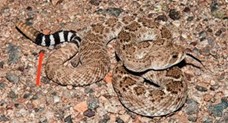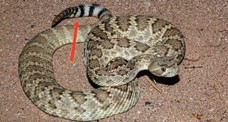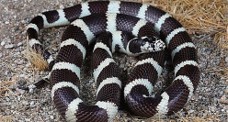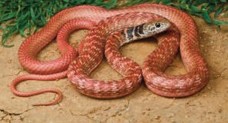The weather forecast for the next several months is predicted to be mostly sunny with a chance of rattlesnakes, especially if you live outside the concrete jungle.
 The snake on the left is a western diamondback (Crotalus Atrox). It’s more aggressive, strikes fast and averages about 4 feet but can hypothetically grow up to about 7 feet if you don’t remove its head with a flat shovel or blow it off with bird shot while it’s small. It’s venom basically liquifies tissue, and causes severe swelling, muscle necrosis, internal bleeding, organ damage, headaches, nausea, vomiting, and abdominal pain. It’s commonly encountered in our area.
The snake on the left is a western diamondback (Crotalus Atrox). It’s more aggressive, strikes fast and averages about 4 feet but can hypothetically grow up to about 7 feet if you don’t remove its head with a flat shovel or blow it off with bird shot while it’s small. It’s venom basically liquifies tissue, and causes severe swelling, muscle necrosis, internal bleeding, organ damage, headaches, nausea, vomiting, and abdominal pain. It’s commonly encountered in our area.
According to Dr. Patrick Jones DVM, a clinical herbalist and traditional naturopath who runs the HomeGrown Herbalist School of Botanical Medicine and has experience treating both humans and animals, echinacea neutralizes an enzyme (hyaluronidase) in most rattlesnake venom and also treats Brown Recluse spider bites. Although it’s better known as an immune booster for treating colds and other viruses such as chickenpox and shingles, you might want to keep some echinacea handy if you or a pet is bitten. Immediately take orally and and also make a topical poultice from the contents of the capsules before rushing off to see a doctor.
 The snake on the right is a Mojave (green). It’s often but not always shades of khaki, much deadlier and somewhat smaller, optimally maxing out at about 4 1/2 feet if you foolishly allow it to live. It’s venom usually contains a deadly neurotoxin.
The snake on the right is a Mojave (green). It’s often but not always shades of khaki, much deadlier and somewhat smaller, optimally maxing out at about 4 1/2 feet if you foolishly allow it to live. It’s venom usually contains a deadly neurotoxin.
According to Dr. Bryan Ardis, who has become a recognized expert on venom, both nicotine and N-Acetyl Cysteine (NAC), a supplement also known for preventing hangovers, bind to the same chemical receptors in your brain as neurotoxic snake venom, thereby blocking it. NAC, or nicotine gum, pouches or patches might be a helpful mitigation strategy on your way directly to the ER in Las Vegas.
One way to distinguish between these two similar rattlesnakes is that the stripes next to their rattles are slightly different, but even this can vary somewhat. The western diamondback usually has equally wide bright white and black bands, while the Mohave usually has wider white band than black and the bands may also be more beige or light greyish with khaki stripes instead of black.
Snakes seem to be most active when it’s about 85° but seek shade in extreme heat, especially if there's a moist spot in the dirt from a leaky hose or swamp cooler line. According to "Rattlesnake Solutions", rattlesnakes cannot handle prolonged direct sunlight in 90° or higher temps, and 105° or higher is lethal to them.
Where you’re likely to encounter one may depend on the time of day and the temperature, as they come out to warm up in the mornings, nap in the shade midday, and then come back out at dusk to hunt. You might also see a snake on the road taking advantage of the remaining warmth in the cool morning hours.
Relocating rattlesnakes in populated areas is essentially public endangerment, forcing someone else to kill them. They are also territorial hunters and may find their way home. Yes, you can eat rattlesnakes so don’t let a good kill go to waste.
 Never kill good snakes. Coachwhips and King snakes will eat rattlesnakes, but bull snakes and gopher snakes do not, that’s an urban legend. Fine mesh or bird netting around the bottom of your animal enclosures will help keep snakes out.
Never kill good snakes. Coachwhips and King snakes will eat rattlesnakes, but bull snakes and gopher snakes do not, that’s an urban legend. Fine mesh or bird netting around the bottom of your animal enclosures will help keep snakes out.
*Disclaimer, this article is for information purposes only and should not be considered as medical advice.

